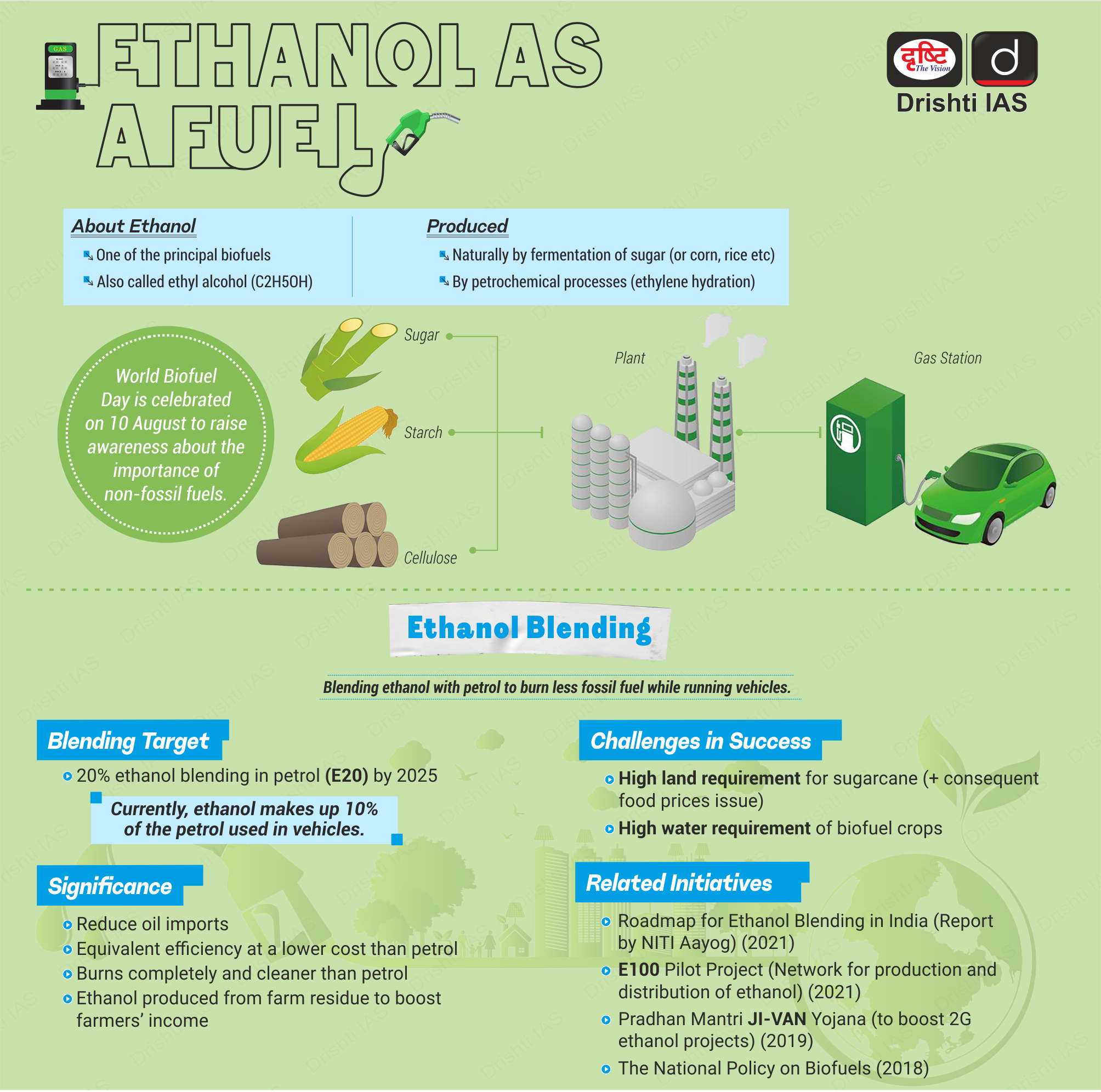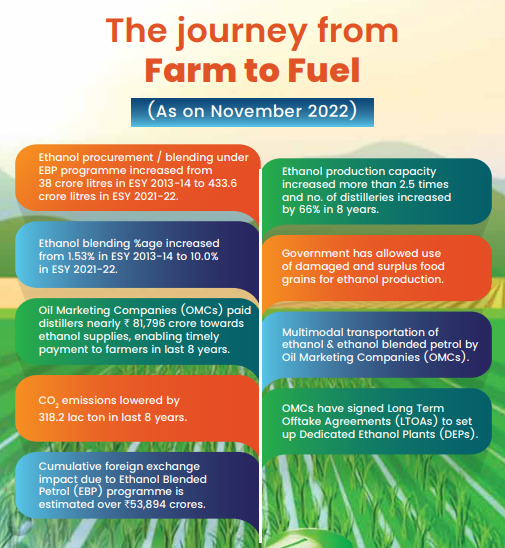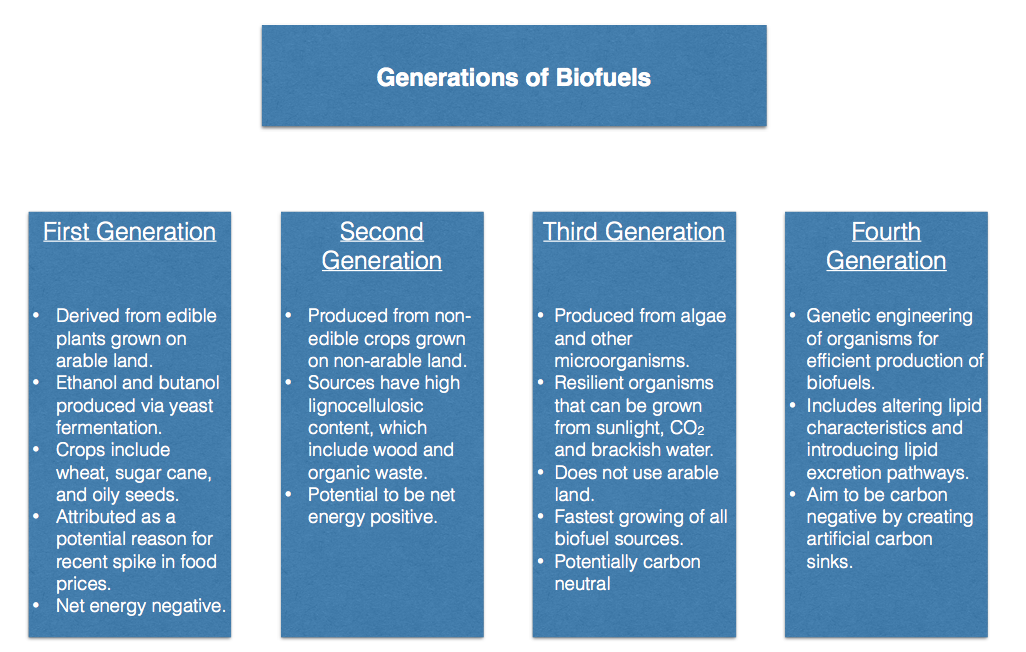Indian Economy
World Biofuels Day 2024
- 12 Aug 2024
- 11 min read
For Prelims: Biofuels, Types of Biofuels, Ethanol Blending Program (EBP), National Policy on Biofuels, Differential Ethanol Pricing.
For Mains: Ethanol, Ethanol Blending Program: Significance, Challenges, Government Policies and Way Forward.
Why in News?
Recently, World Biofuel Day was observed on 10th August 2024. It aims to raise awareness about non-fossil fuels as sustainable energy alternatives and to highlight government initiatives that support the biofuel industry.
- The day also commemorates the successful operation of an engine on peanut oil by German engineer Sir Rudolf Diesel on 9th August 1893.
What are Biofuels?
- About:
- Biofuels are the fuel derived from the biomass of plants or animal wastes.
- It is commonly produced from corn, sugarcane and animal waste like cow dung.
- These come under renewable sources of energy.
- Most Common Biofuels:
- Ethanol: It is produced by fermentation of crop residues such as corn and sugarcane. After fermentation, the ethanol is mixed with petroleum, diluting it and reducing emissions.
- The most common blend is Ethanol-10, which contains 10% ethanol.
- Ethanol used in fuel is 99.9% pure alcohol, while 96% extra neutral alcohol is used in potable liquor and 94% rectified spirit is found in paints, cosmetics, pharmaceuticals, and other industrial products.
-
Biodiesel: It is a renewable, biodegradable fuel made from used cooking oil, recycled restaurant grease, yellow grease, or animal fats.
- Its production involves burning the oil or fat with alcohol in the presence of a catalyst.
- Ethanol: It is produced by fermentation of crop residues such as corn and sugarcane. After fermentation, the ethanol is mixed with petroleum, diluting it and reducing emissions.
- Significance:
- Environmental Benefits: Biofuels are crucial for environmental sustainability as they can help alleviate some of the negative impacts of fossil fuel use, such as greenhouse gas emissions and resource depletion and they also offer improved waste management solutions.
- Energy Security: India, the world's third-largest crude oil consumer, imports over 85% of its oil. With rising energy demand and heavy reliance on imports, biofuels can help improve energy security.
- Economic Benefits: Biofuels can cut India's oil imports and import bill, while also boosting farm incomes and addressing surplus production of crops like corn and sugarcane.
- Abundant Availability: Biofuels can be produced from a variety of sources, including crops, waste, and algae.
What are the Government Initiatives and Policies on Biofuels?
- National Policy on Biofuel, 2018: It aims to reduce import dependence by promoting fuel blending with bioethanol, biodiesel, and bio-CNG.
- Key elements include the Ethanol Blending Programme (EBP), production of second-generation ethanol (derived from forest and agricultural residues), increasing local fuel additive production under the “Make in India” program, and R&D in feedstock.
- In May 2022, the policy was amended to advance the 20% ethanol blending target from 2030 to 2025-26.
- Reduced GST on Ethanol:
- To encourage ethanol blending, the government lowered the Goods and Services Tax (GST) rate on ethanol used for blending under the Ethanol Blended Petrol (EBP) Programme from 18% to 5%.
- Pradhan Mantri JI-VAN Yojana, 2019:
- It aims to boost Second Generation (2G) ethanol production from cellulosic and lignocellulosic sources, including petrochemical routes, by offering financial support.
- Lignocellulosic biomass (or LC biomass) refers to plant biomass that is composed of cellulose, hemicellulose, and lignin. For examples cereal straw, bagasse, forest residues, and purpose-grown energy crops such as vegetative grasses.
- The government has approved an extension of the scheme's implementation timeline by 5 years, now running until 2028-29.
- GOBAR (Galvanizing Organic Bio-Agro Resources) DHAN Scheme, 2018:
- It focuses on managing and converting cattle dung and solid waste in farms to useful compost, biogas and bio-CNG, thus keeping villages clean and increasing the income of rural households.
- It was launched under the Swachh Bharat Mission (Gramin).
- Repurpose Used Cooking Oil (RUCO):
- It was launched by the Food Safety and Standards Authority of India (FSSAI) and aims for an ecosystem that will enable the collection and conversion of used cooking oil to biodiesel.
- Global Biofuels Alliance (GBA): It is a multi-stakeholder alliance to facilitate international cooperation and promote the use of sustainable biofuels.
- It was formally launched in 2023 by India along with the leaders of the USA, Brazil, Italy, Argentina, Singapore, Bangladesh, Mauritius and the UAE on the sidelines of the G20 Summit in New Delhi.
- Additionally, it aims to facilitate global biofuel trade and provide technical support for national biofuel programs.
Note:
- The first 2G ethanol project was inaugurated in Panipat, Haryana in 2022.
- Ethanol blending increased from 38 crore liters in 2013-14 to over 500 crore liters in 2022-23.
- Blending percentage rose from 1.53% to 12.06%, reaching 15.83% in July 2024.
- Oil Marketing Companies (OMCs) aim for a 20% ethanol blending target by the end of Ethanol Supply Year (ESY) 2025-26, requiring approximately 1,100 crore litres of ethanol.
- A total of 1,750 crore litres of ethanol distillation capacity is needed to meet blending requirements.
What are the Challenges Related to Biofuels?
- Environmental Issues: Biofuel production can strain land and water resources, cause pollution, and alter cropping patterns.
- Producing one litre of ethanol from sugar requires about 2,860 litres of water.
- Food vs. Fuel Challenge: There are concerns about balancing food security with energy security, depending on the choice of feedstock and production methods for biofuels.
- The availability and cost of these feedstocks can fluctuate based on factors like season, weather, market conditions, and policy changes.
- Conversion Efficiency and Yield: Ethanol production involves pretreatment, hydrolysis, fermentation, and distillation, with varying efficiencies and yields depending on feedstock type, process technology, and conditions.
- For example, lignocellulosic biomass, which is more abundant and diverse than sugarcane or corn, requires more intensive and complex pretreatment and hydrolysis to break down the cellulose and hemicellulose into fermentable sugars.
- The conversion efficiency and yield of ethanol also affect the economic viability and environmental impact of the production process.
- Infrastructure and Distribution: Ethanol production needs robust infrastructure for transporting, storing, and delivering feedstock and fuel, which can be costly and face logistical and regulatory challenges.
- For example, ethanol is corrosive and hygroscopic, which means that it can damage or contaminate the existing pipelines, tanks, and pumps that are designed for gasoline or diesel.
- Vehicle Compatibility and Performance: Vehicles need modifications to run on ethanol-blended fuels or pure ethanol, affecting engines, fuel systems, and maintenance practices.
- For example, Ethanol has a lower energy density than gasoline, which means that more volume of ethanol is needed to provide the same amount of energy, resulting in higher transportation and storage costs.
Way Forward
- Production Boost: Diversify feedstock by using non-food sources and waste, support R&D for advanced biofuels, expand and modernise production facilities, and establish distilleries near fuel depots to reduce costs and enhance logistics.
- Policy and Market Mechanisms: Gradually raise the ethanol blending mandate beyond 20% by 2025, establish fixed-price contracts with oil companies to ensure market stability, and invest in R&D for optimising blending ratios, engine compatibility, and conversion technologies.
- Technological Advancement: Invest in improved storage and transportation infrastructure, collaborate with automakers to develop ethanol-compatible engines, and enforce strict quality standards for ethanol to ensure performance and safety.
- Public Awareness and Education: Launch campaigns to educate consumers on the benefits of ethanol blending, address misconceptions, and encourage adoption. Ensure clear labelling of ethanol-blended fuels at stations to inform choices.
|
Drishti Mains Question Discuss the importance of India's Ethanol Blending Program in enhancing energy security, decreasing reliance on fossil fuels, and minimising environmental impact. |
UPSC Civil Services Examination, Previous Year Questions (PYQ)
Q. Given below are the names of four energy crops. Which one of them can be cultivated for ethanol? (2010)
(a) Jatropha
(b) Maize
(c) Pongamia
(d) Sunflower
Ans: (b)
Q. According to India’s National Policy on Biofuels, which of the following can be used as raw materials for the production of biofuels? (2020)
- Cassava
- Damaged wheat grains
- Groundnut seeds
- Horse gram
- Rotten potatoes
- Sugar beet
Select the correct answer using the code given below:
(a) 1, 2, 5 and 6 only
(b) 1, 3, 4 and 6 only
(c) 2, 3, 4 and 5 only
(d) 1, 2, 3, 4, 5 and 6
Ans: (a)







